Last Updated 4/18/04
Website Index
The Zholith Desert (aka al-Jholith or al-Kholith)
The Zholith (Anvil) , desert is a large geologic depression that was once
a lake basin dominated by Lake Ariana, an ancient fresh water lake. It lies
to the south and east of the Plateau of Leng, North and West of the great
tableland (Al-Faraq) covered by the Faraka wastes. To the east lies the plateau
covered by the Jhoz Desert. It is a forbidding place, a fringe territory,
with poor grazing for sheep and goats, few surface water sources and limited
game and vegetation for hunting and gathering. That it is inhabited at all
is largely a product of the caravans that pass through that provide economic
opportunities in the form of jobs, trade and plunder. The inhabitants as
frequently use weapons of bone or stone, as much as the bronze of their richer
neighbors. The inhabitants are by and large poor materially, but rich in
pride, heart, bravery and endurance. Most folk are slight of build, but strong
in a wiry sort of way, and quick of reflex.
The area of the Zholith once covered by Lake Ariana is now a region of dunes known as the Taljiq-Saqqar (Shifting Sands) .
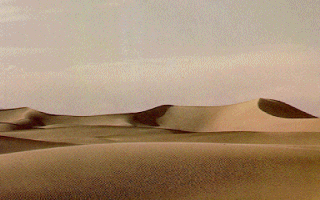 It is the home of giant scorpions,
sand lions, Sandships crewed by the ruthless pirates and outlaws, and other
perils. Dust storms are a frequent hazard. The ruins of five ancient cities
(Khadesib, Ghazunghazad, Miradhal, Belfharghan, and Rhazaj-Uyu) as well as
numerous villages can be found in the sands, sometimes exposed by winds,
sometimes covered. These ancient settlements once lay either on islands in
the old lake or along its shores. The lure of ancient treasures brings many
an adventurer to the Taljik-Saqqar, but few return. Pelai raiders are sometimes
seen flying over the Taljiq-Saqqar
It is the home of giant scorpions,
sand lions, Sandships crewed by the ruthless pirates and outlaws, and other
perils. Dust storms are a frequent hazard. The ruins of five ancient cities
(Khadesib, Ghazunghazad, Miradhal, Belfharghan, and Rhazaj-Uyu) as well as
numerous villages can be found in the sands, sometimes exposed by winds,
sometimes covered. These ancient settlements once lay either on islands in
the old lake or along its shores. The lure of ancient treasures brings many
an adventurer to the Taljik-Saqqar, but few return. Pelai raiders are sometimes
seen flying over the Taljiq-Saqqar
To the west of this region is an area of broken rugged desert terrain known
as al-Ghadzul-Maraqhash (Dragon's Jaw) .
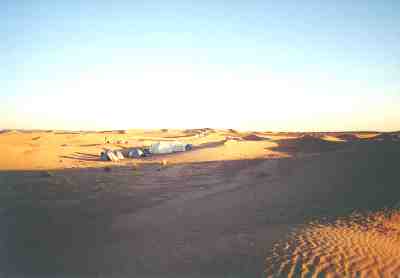 This area is inhabited mainly by
Dervish tribes. It is the route through which caravans of spices and exotic
goods from the Far Kingdoms travel to the Delta, and where silk caravans
bearing the fine textiles and other crafts of the Delta travel to the Oasis
Kingdoms and the Far Kingdoms with return wares. A number of medicinal roots
and herbs grow here. It has the best grazing lands and most oases and surface
water sources of any part of the Zholith. Most of the human population of the desert is located in this region. In ancient times this area was a half-wild frontier of trappers,miners,traders and clay diggers. The clays of this region then known as Vaja were prized throught Gondwana for their use in porcelains, stonewares and alchemy. There were nineteen varieties. Today the area is dominted by rough earth rocks and brush, and most of the clays that are found are suitable only for crude earthenwares. Still rare deposits of the prized clays are occassionally found. In the past the area dominated by nine towns (Ghevan, Kijkil,Wesh, Quqol, Fhazane,Rupilia,Eywadi,Haqu, and Mundax) whose relict traces remain as haunted places or ceremonial grounds.
This area is inhabited mainly by
Dervish tribes. It is the route through which caravans of spices and exotic
goods from the Far Kingdoms travel to the Delta, and where silk caravans
bearing the fine textiles and other crafts of the Delta travel to the Oasis
Kingdoms and the Far Kingdoms with return wares. A number of medicinal roots
and herbs grow here. It has the best grazing lands and most oases and surface
water sources of any part of the Zholith. Most of the human population of the desert is located in this region. In ancient times this area was a half-wild frontier of trappers,miners,traders and clay diggers. The clays of this region then known as Vaja were prized throught Gondwana for their use in porcelains, stonewares and alchemy. There were nineteen varieties. Today the area is dominted by rough earth rocks and brush, and most of the clays that are found are suitable only for crude earthenwares. Still rare deposits of the prized clays are occassionally found. In the past the area dominated by nine towns (Ghevan, Kijkil,Wesh, Quqol, Fhazane,Rupilia,Eywadi,Haqu, and Mundax) whose relict traces remain as haunted places or ceremonial grounds.
To the north of the Taljiq-Saqqar is the Seddif-Khazom (Crimson Mesas)
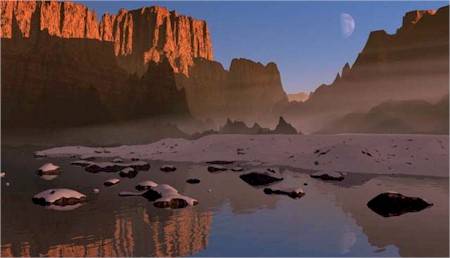 It is also riddled by caves,caverns and underground passageways. Caravans must pass this way on there way to Tretachme and beyond to Junjoli, the gateway to the Delta. The crimson mesas contains the cave of Antac as well as many important ceremonial sites for the desert clans. It contains some very valuable alchemical mineral compounds and exotic desert plants and fauna. Red ochre is common in sand this area giving the region its distinctive color.
Another reason is the bloody raids on caravans, and battles between desert clans that have occurred here staining the desert red. It is also an area known for deposits of the valuable starstone. Much of it is in layers of rust that stain the soil, but more useful deposits can be found less commonly in the interior of seemingly non-descipt nodulesT that a trained eye learns to discern from the other desert rocks. In ancient times this area was a great pine forest.
It is also riddled by caves,caverns and underground passageways. Caravans must pass this way on there way to Tretachme and beyond to Junjoli, the gateway to the Delta. The crimson mesas contains the cave of Antac as well as many important ceremonial sites for the desert clans. It contains some very valuable alchemical mineral compounds and exotic desert plants and fauna. Red ochre is common in sand this area giving the region its distinctive color.
Another reason is the bloody raids on caravans, and battles between desert clans that have occurred here staining the desert red. It is also an area known for deposits of the valuable starstone. Much of it is in layers of rust that stain the soil, but more useful deposits can be found less commonly in the interior of seemingly non-descipt nodulesT that a trained eye learns to discern from the other desert rocks. In ancient times this area was a great pine forest.
The Dweorgha-Var is 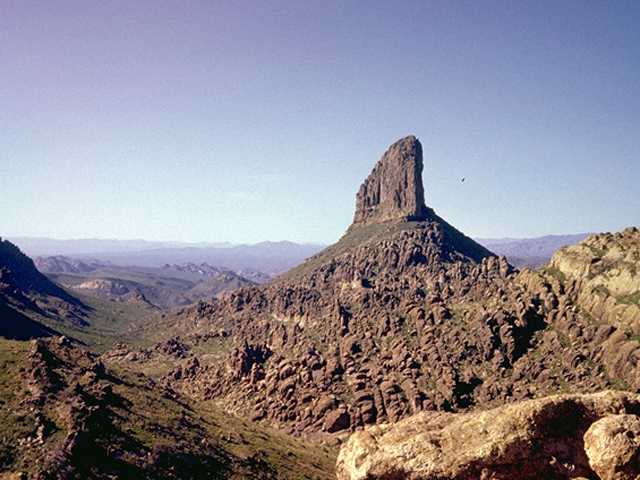 the
rugged piedmont of the Mountains of Madness. This area is heavily contested
by Dust Dwarf, Sand-elf and Dervish clans.
the
rugged piedmont of the Mountains of Madness. This area is heavily contested
by Dust Dwarf, Sand-elf and Dervish clans.
To the east of Taljiq-Saqqar are the Brimstone Hills (Huzakh-Var) . This area
contains a number of volcanic vents, and is plagued by frequent earthquakes.
The vegetation is distinctly unfriendly , consisting of mostly inedible plants
including poisonous thorny shrubs, stinging nettles and dangerous fungi that
shoot deadly spores. This area is inhabited by wyverns, giant lizards, sand
wasps and packs of armored rodents known as Pwarqaab (Rock Rats). The animals
and vegetation make this one of the most dangerous parts of the Jholith.
It is also one of the richest mineralogically. It contains tin, copper, precious
alchemical compounds like: Maruk (magical mordant for binding potions), Bhavade
(useful in Alteration magic), Tajhuk (Sands of Enchantment) and Zelwaythe
(Divination). It is also a rich source of starstone (iron). The potential
riches of the Brimstone hills bring many expeditions , but the hazards take
their toll. Pelai slaving expeditions raid the Brimstone hills frequently
seizing both slaves and treasure.
To the south of the Taljiq-Saqqar are the Mountains of the Mystics (Shari-Wazir
Khokhazume). Except for a Haz trading station at the edge of these Mountains
at the mouth of Doomgate Pass, these mountains are taboo, although the source
of many myths and legends. Dervish folk believe that during the Wizard Wars,
the Magi of Ariana retreated to redoubts in secret vales nestled between
these purple peaks, and that they dwell there to this day killing all who
dare trespass on their domain. Other legends say that these mountains are
the homelands of the terrible Pelai raiders, while others talk about hidden
elvish kingdoms, cities of lizardmen (Haz) and caves of dragons. It is the gatway to the Great Salt Wastes and the high desert of the Al-Faraqa beyond.
North of the Crimson mesas and extending to the Delta is the vast harsh country of the Tretachme 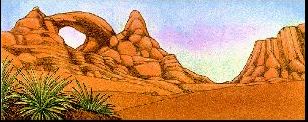 The ruins of the ancient city of
Zharnath are found in the Tretachme. About five years ago, with the retreat of "rebel" armies from the Southern Delta into the Zholith, the Tretachme has become embroiled in the civil war between the Hegemon of the Delta and the Rebels. It was the main source of Alum used in the textile industries of The Delta. The Alum mines are worked by convicts brought in from the Delta
and guarded by mercenaries recruited from Sand-elf or Dervish clans. These ave become the target of rebel raids, and most have been abandoned. In ancient times, the Tretachme was a great forest of sequoias, whose fossilized remnants can sometimes be found in among the rocks, and whose ancient splendor is sometimes seen in occasional mirages.
The ruins of the ancient city of
Zharnath are found in the Tretachme. About five years ago, with the retreat of "rebel" armies from the Southern Delta into the Zholith, the Tretachme has become embroiled in the civil war between the Hegemon of the Delta and the Rebels. It was the main source of Alum used in the textile industries of The Delta. The Alum mines are worked by convicts brought in from the Delta
and guarded by mercenaries recruited from Sand-elf or Dervish clans. These ave become the target of rebel raids, and most have been abandoned. In ancient times, the Tretachme was a great forest of sequoias, whose fossilized remnants can sometimes be found in among the rocks, and whose ancient splendor is sometimes seen in occasional mirages.

The Mountains of Madness (Janizikh Khokhazume)
The Mountains of Madness are a region of majestic peaks and narrow valleys
and canyons. It is arid, pinyon-juniper dominated vegetation, with stands
of oak, wild cherry, pine and mushnut trees in the vales. It is populated
mainly by Dust Dwarves. It is named for the Janiz root, a narcotic chewed
by the Dust Dwarves to make them brave bezerkers in warfare, and also part
of the alchemical formula for creating the Jannisaries of the Delta.
Jhoz Desert
The Jhoz Desertis a miserable inhospitable plateau of sun-baked outcrops of rock, covered in
places by dunes. Places that were said in antiquity to be lakes and streams
have been altered by foul magic into flows of black, red and green obsidian.
Volcanic vents dot the region, and lava can occasionally be scene flowing
across parts of the Jhoz. There is little in the way of potable water or
edible plant life in the Jhoz. its very name is a dervish term for sun-bleached
bones
 This area is inhabited mainly by
Dervish tribes. It is the route through which caravans of spices and exotic
goods from the Far Kingdoms travel to the Delta, and where silk caravans
bearing the fine textiles and other crafts of the Delta travel to the Oasis
Kingdoms and the Far Kingdoms with return wares. A number of medicinal roots
and herbs grow here. It has the best grazing lands and most oases and surface
water sources of any part of the Zholith. Most of the human population of the desert is located in this region. In ancient times this area was a half-wild frontier of trappers,miners,traders and clay diggers. The clays of this region then known as Vaja were prized throught Gondwana for their use in porcelains, stonewares and alchemy. There were nineteen varieties. Today the area is dominted by rough earth rocks and brush, and most of the clays that are found are suitable only for crude earthenwares. Still rare deposits of the prized clays are occassionally found. In the past the area dominated by nine towns (Ghevan, Kijkil,Wesh, Quqol, Fhazane,Rupilia,Eywadi,Haqu, and Mundax) whose relict traces remain as haunted places or ceremonial grounds.
This area is inhabited mainly by
Dervish tribes. It is the route through which caravans of spices and exotic
goods from the Far Kingdoms travel to the Delta, and where silk caravans
bearing the fine textiles and other crafts of the Delta travel to the Oasis
Kingdoms and the Far Kingdoms with return wares. A number of medicinal roots
and herbs grow here. It has the best grazing lands and most oases and surface
water sources of any part of the Zholith. Most of the human population of the desert is located in this region. In ancient times this area was a half-wild frontier of trappers,miners,traders and clay diggers. The clays of this region then known as Vaja were prized throught Gondwana for their use in porcelains, stonewares and alchemy. There were nineteen varieties. Today the area is dominted by rough earth rocks and brush, and most of the clays that are found are suitable only for crude earthenwares. Still rare deposits of the prized clays are occassionally found. In the past the area dominated by nine towns (Ghevan, Kijkil,Wesh, Quqol, Fhazane,Rupilia,Eywadi,Haqu, and Mundax) whose relict traces remain as haunted places or ceremonial grounds.  It is the home of giant scorpions,
sand lions, Sandships crewed by the ruthless pirates and outlaws, and other
perils. Dust storms are a frequent hazard. The ruins of five ancient cities
(Khadesib, Ghazunghazad, Miradhal, Belfharghan, and Rhazaj-Uyu) as well as
numerous villages can be found in the sands, sometimes exposed by winds,
sometimes covered. These ancient settlements once lay either on islands in
the old lake or along its shores. The lure of ancient treasures brings many
an adventurer to the Taljik-Saqqar, but few return. Pelai raiders are sometimes
seen flying over the Taljiq-Saqqar
It is the home of giant scorpions,
sand lions, Sandships crewed by the ruthless pirates and outlaws, and other
perils. Dust storms are a frequent hazard. The ruins of five ancient cities
(Khadesib, Ghazunghazad, Miradhal, Belfharghan, and Rhazaj-Uyu) as well as
numerous villages can be found in the sands, sometimes exposed by winds,
sometimes covered. These ancient settlements once lay either on islands in
the old lake or along its shores. The lure of ancient treasures brings many
an adventurer to the Taljik-Saqqar, but few return. Pelai raiders are sometimes
seen flying over the Taljiq-Saqqar
 It is also riddled by caves,caverns and underground passageways. Caravans must pass this way on there way to Tretachme and beyond to Junjoli, the gateway to the Delta. The crimson mesas contains the cave of Antac as well as many important ceremonial sites for the desert clans. It contains some very valuable alchemical mineral compounds and exotic desert plants and fauna. Red ochre is common in sand this area giving the region its distinctive color.
Another reason is the bloody raids on caravans, and battles between desert clans that have occurred here staining the desert red. It is also an area known for deposits of the valuable starstone. Much of it is in layers of rust that stain the soil, but more useful deposits can be found less commonly in the interior of seemingly non-descipt nodulesT that a trained eye learns to discern from the other desert rocks. In ancient times this area was a great pine forest.
It is also riddled by caves,caverns and underground passageways. Caravans must pass this way on there way to Tretachme and beyond to Junjoli, the gateway to the Delta. The crimson mesas contains the cave of Antac as well as many important ceremonial sites for the desert clans. It contains some very valuable alchemical mineral compounds and exotic desert plants and fauna. Red ochre is common in sand this area giving the region its distinctive color.
Another reason is the bloody raids on caravans, and battles between desert clans that have occurred here staining the desert red. It is also an area known for deposits of the valuable starstone. Much of it is in layers of rust that stain the soil, but more useful deposits can be found less commonly in the interior of seemingly non-descipt nodulesT that a trained eye learns to discern from the other desert rocks. In ancient times this area was a great pine forest.
 the
rugged piedmont of the Mountains of Madness. This area is heavily contested
by Dust Dwarf, Sand-elf and Dervish clans.
the
rugged piedmont of the Mountains of Madness. This area is heavily contested
by Dust Dwarf, Sand-elf and Dervish clans.  The ruins of the ancient city of
Zharnath are found in the Tretachme. About five years ago, with the retreat of "rebel" armies from the Southern Delta into the Zholith, the Tretachme has become embroiled in the civil war between the Hegemon of the Delta and the Rebels. It was the main source of Alum used in the textile industries of The Delta. The Alum mines are worked by convicts brought in from the Delta
and guarded by mercenaries recruited from Sand-elf or Dervish clans. These ave become the target of rebel raids, and most have been abandoned. In ancient times, the Tretachme was a great forest of sequoias, whose fossilized remnants can sometimes be found in among the rocks, and whose ancient splendor is sometimes seen in occasional mirages.
The ruins of the ancient city of
Zharnath are found in the Tretachme. About five years ago, with the retreat of "rebel" armies from the Southern Delta into the Zholith, the Tretachme has become embroiled in the civil war between the Hegemon of the Delta and the Rebels. It was the main source of Alum used in the textile industries of The Delta. The Alum mines are worked by convicts brought in from the Delta
and guarded by mercenaries recruited from Sand-elf or Dervish clans. These ave become the target of rebel raids, and most have been abandoned. In ancient times, the Tretachme was a great forest of sequoias, whose fossilized remnants can sometimes be found in among the rocks, and whose ancient splendor is sometimes seen in occasional mirages.
